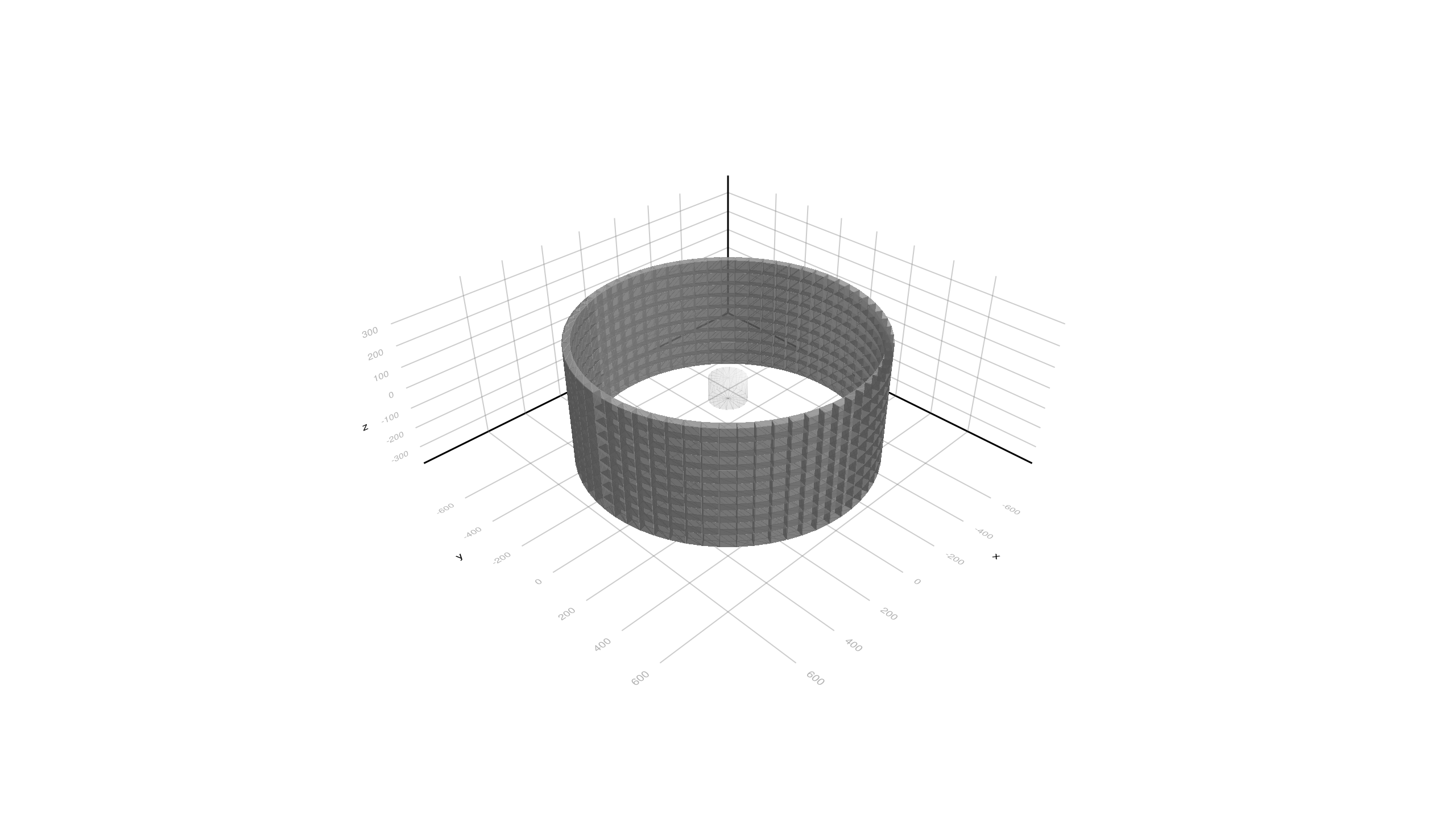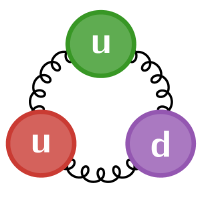Defining Geant4.jl Geometries#
Currently we can define G4 geometries by constructing them using the API of the C++ classes or by reading a GDML file. This notebook will guide you on this task.
It is very convenient to be able to visualize the geometry on the way. For this purpose we need to load the G4Vis extension. This is done this way:
using Geant4
using Geant4.SystemOfUnits # defines the units used by Geant4 (e.g. MeV, mm, ns, ...)
using CairoMakie, Rotations, LinearAlgebra, IGLWrap_jll # to force loading G4Vis extension
Defining Solids#
The first step is to define the solids. The following shapes are defined: G4Box, G4Cons, G4Tubs, G4Orb, G4Sphere, G4Trd, G4CutTubs, G4Para, G4Trap, G4Torus, G4Polycone, G4Polyhedra, G4EllipticalTube, G4Ellipsoid, G4EllipticalCone, G4Paraboloid, G4Hype, G4Tet, G4ExtrudedSolid, G4TwistedBox, G4TwistedTrap, G4TwistedTrd, G4GenericTrap, G4TwistedTubs. In addition, there are the boolean shapes: G4UnionSolid, G4SubtractionSolid, G4IntersectionSolid.
The definition of the constructor parameters can be found in the documentation
Lets define a tube section like the following:
rmin = 10cm
rmax = 20cm
halfz = 10cm
ϕ₀ = 0
Δϕ = 60deg
tube = G4Tubs("tube", rmin, rmax, halfz, ϕ₀, Δϕ )
Geant4.G4TubsAllocated(Ptr{Nothing} @0x000000000584f870)
We can easily draw the just constructed solid
img = draw(tube, wireframe=true)
display("image/png", img) # This is needed specially for notebooks
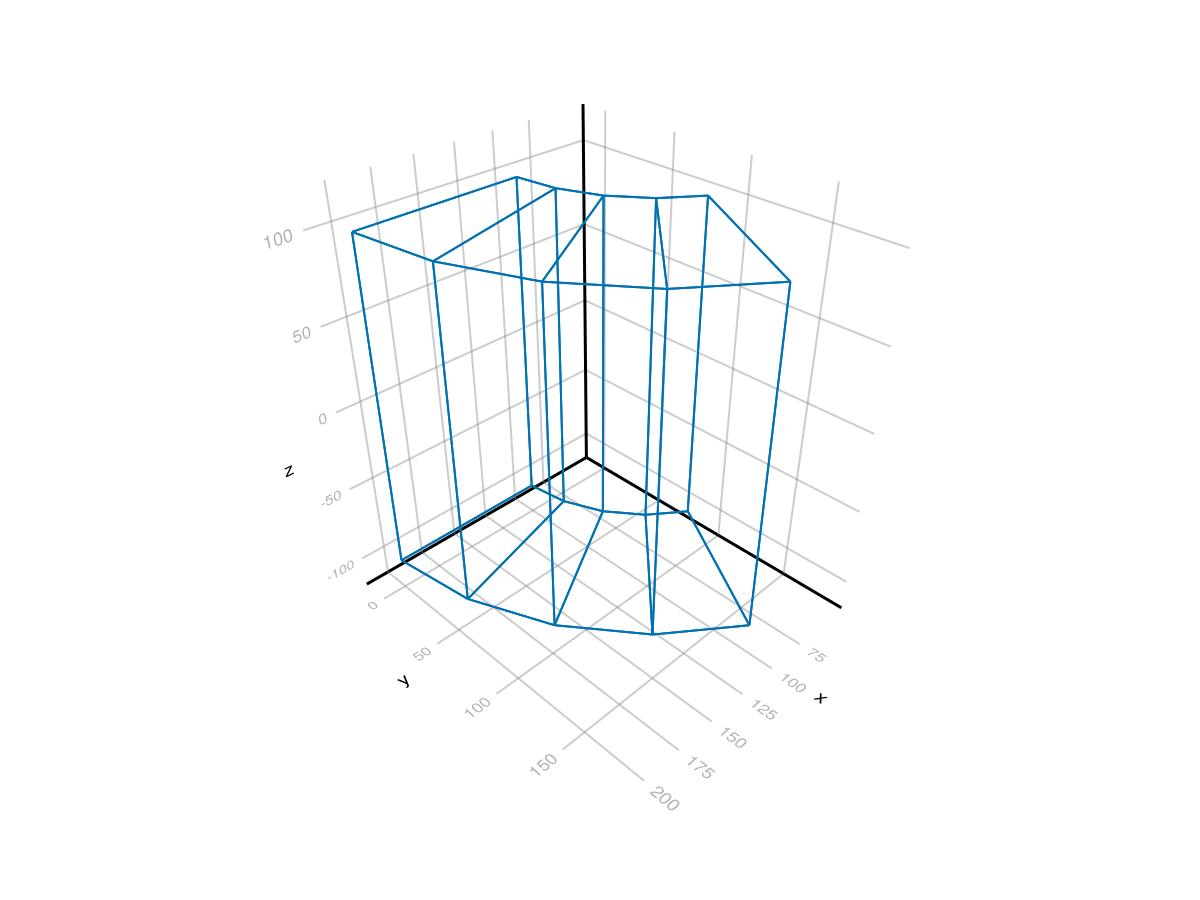
para = G4Para("parallelepiped", 30,40,60,0, π/4, π/6)
img = draw(para)
display("image/png", img)
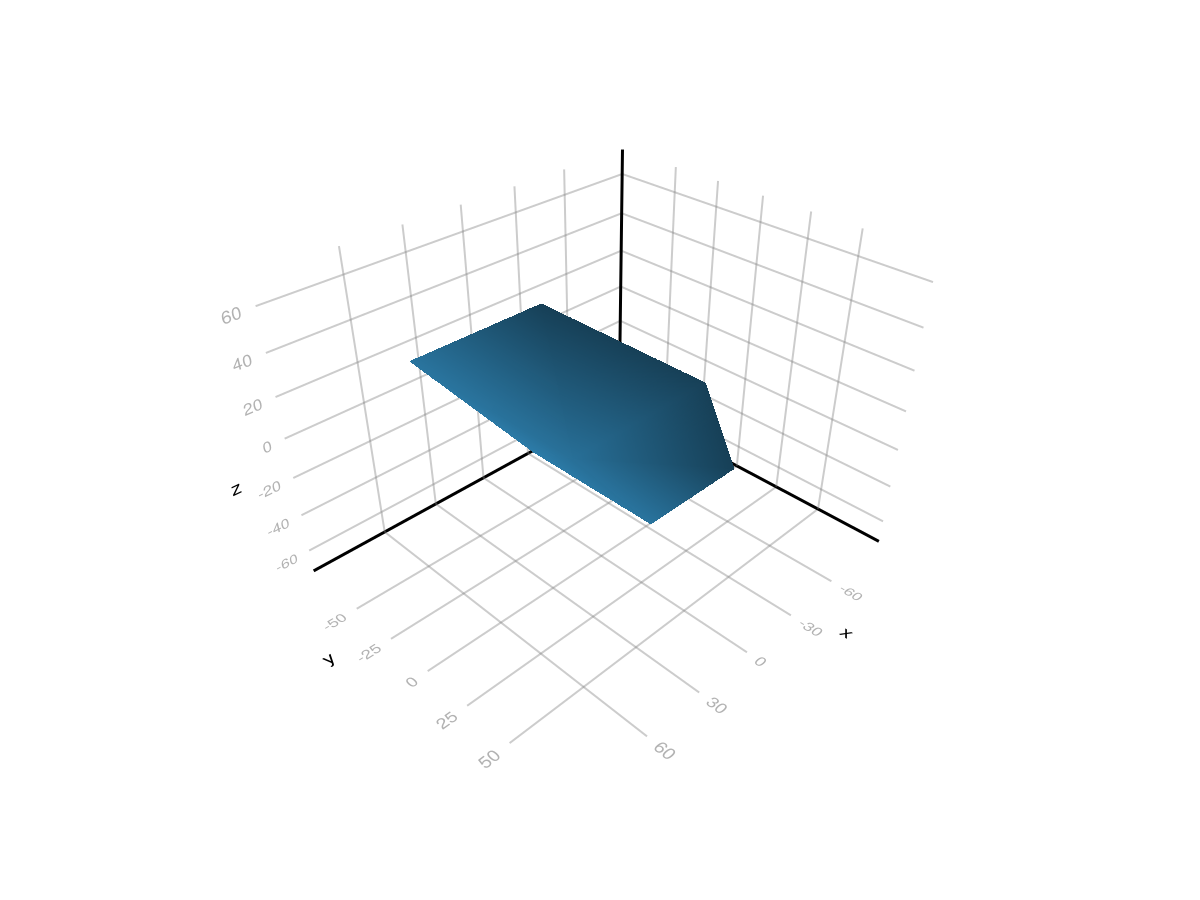
Building Boolean solids#
We can build more complex geometries by combining with boolean operations simple shapes. For example building a 3D cross.
box = G4Box("box", 1, 1, 4)
t = G4Transform3D(G4RotationMatrix(0,π/2,0), G4ThreeVector())
cross = G4UnionSolid("cross", CxxPtr(box), CxxPtr(box), t)
img = draw(cross)
isnothing(img) || display("image/png", img)
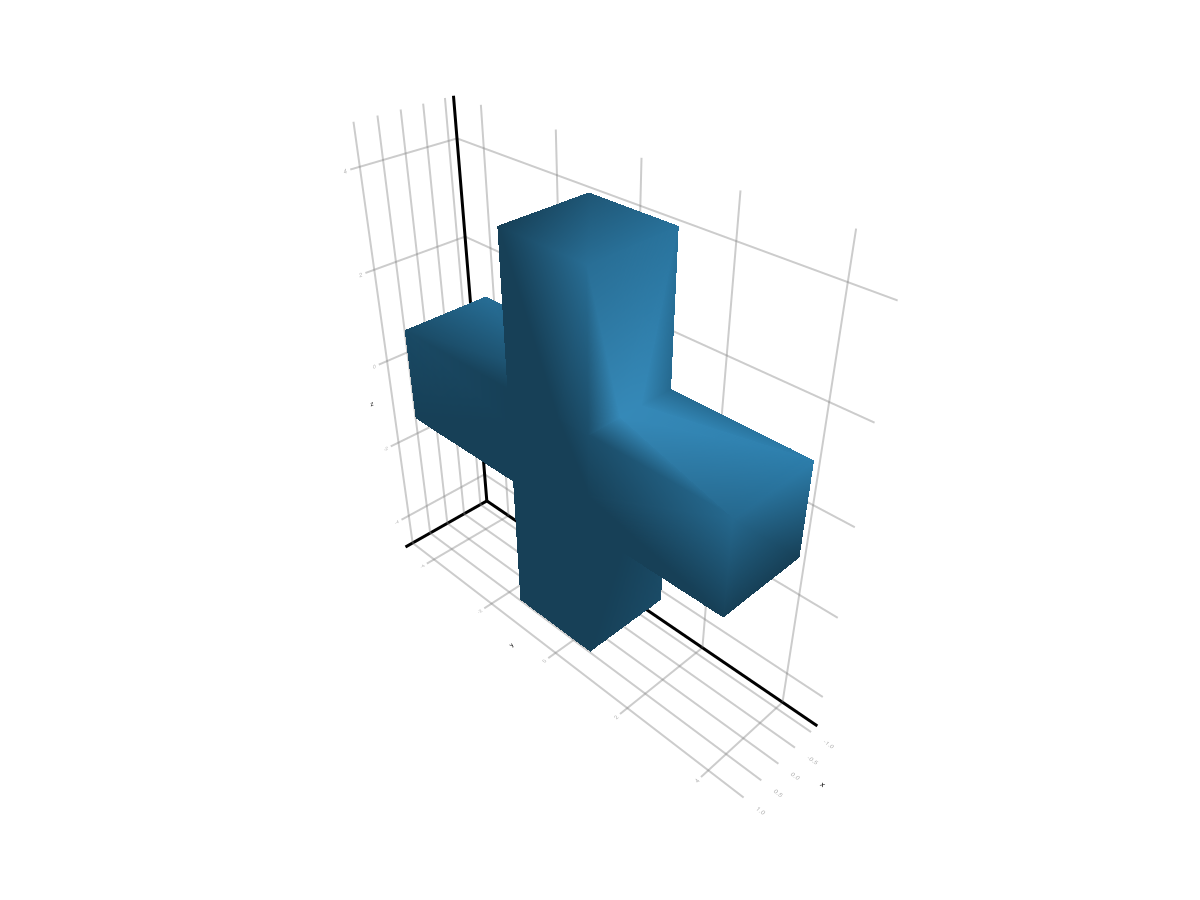
Lets use some geometry functionality to experiment with the created solid. In this example we get the limits for the boolean solid and create a number if radom 3D points within the limits. Then select the ones that return kInside when calling the function Inside(solid, point). And finally, we plot the points with scatter function from Makie.
using StaticArrays
const Vector3 = SVector{3}
N = 100000
lo = G4ThreeVector()
hi = G4ThreeVector()
BoundingLimits(cross, lo, hi) # get the bounding limits
dim = hi - lo
points = (lo + dim * rp for rp in rand(Vector3{Float64}, N)) # random points within the limits
result = [Vector3{Float64}(x(p), y(p), z(p)) for p in points if Geant4.Inside(cross, p) == kInside]
img = scatter(result, color=:black, markersize=1)
display("image/png", img)
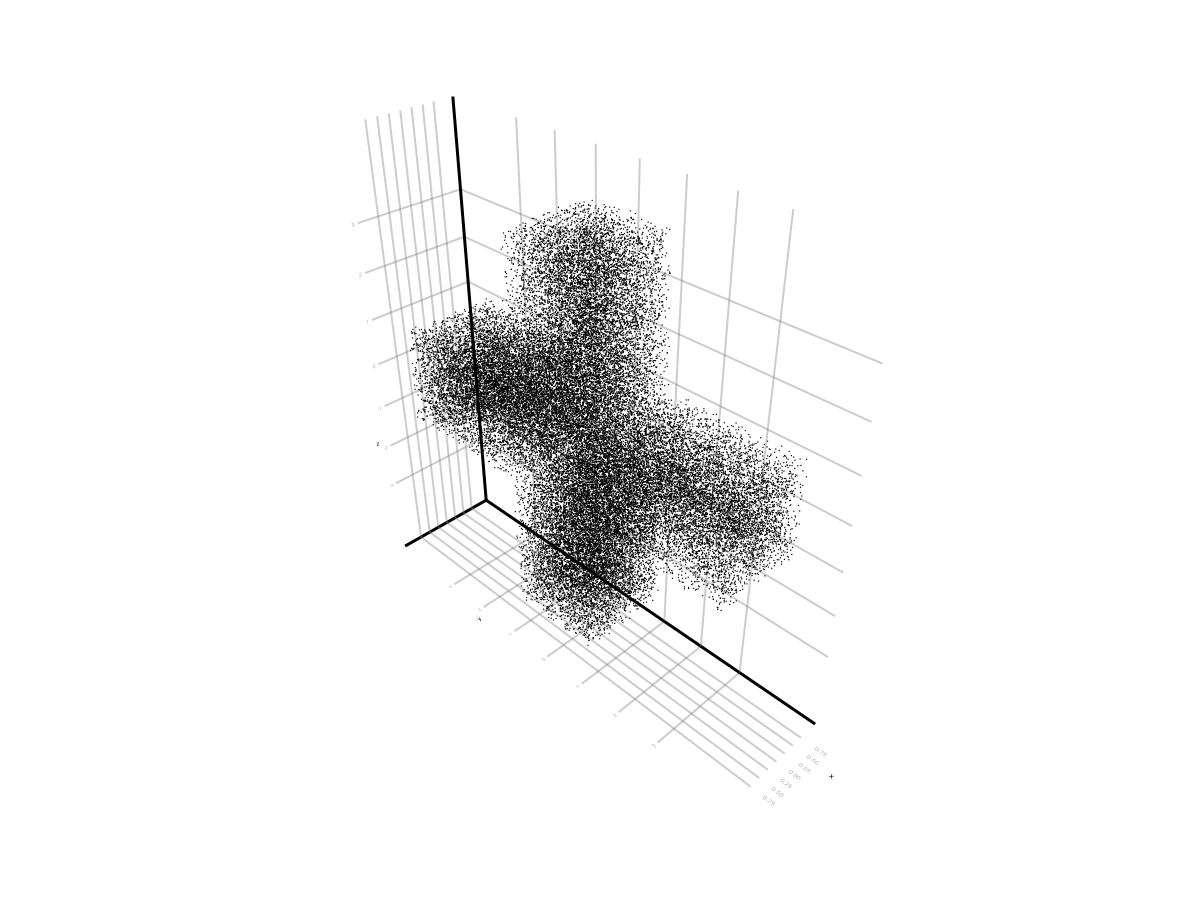
Defining Materials#
In nature, materials (chemical compounds, mixtures) are made of elements, and elements are made of isotopes. Geant4 offers the 3 classes G4Isotope, G4Element and G4Materialto define from first principles any material. However is often that pre-defined materials are available in Geant4 from the NIST database of elements and isotope compositions.
This is the easiest way to get a material.
nist = G4NistManager!Instance()
m_air = FindOrBuildMaterial(nist, "G4_AIR")
@show GetDensity(m_air)/(g/cm3)
m_water = FindOrBuildMaterial(nist, "G4_WATER")
@show GetDensity(m_water)/(g/cm3)
GetDensity(m_air) / (g / cm3) = 0.0012047899999999999
GetDensity(m_water) / (g / cm3) = 1.0
1.0
or alternatively we can construct it from isotopes
U5 = G4Isotope("U235", z=92, n=235, a=235.01*g/mole)
U8 = G4Isotope("U238", z=92, n=238, a=238.03*g/mole)
U = G4Element("Enriched Uranium", "U", 2)
AddIsotope(U, move!(U8), 0.90) # Please notice the use of move!() to transfer ownership
AddIsotope(U, move!(U5), 0.10) # Please notice the use of move!() to transfer ownership
m_eU = G4Material("enriched U", density= 19.1*g/cm3, ncomponents=1)
AddElement(m_eU, move!(U), natoms=1) # Please notice the use of move!() to transfer ownership
@show GetDensity(m_eU)/(g/cm3)
@show GetA(m_eU)/(g/mole)
GetDensity(m_eU) / (g / cm3) = 19.1
GetA(m_eU) / (g / mole) =
237.72800000000004
237.72800000000004
or build a molecule
O = FindOrBuildElement(nist, "O")
Si = FindOrBuildElement(nist, "Si")
Lu = FindOrBuildElement(nist, "Lu")
Lu₂SiO₅ = G4Material("Lu2SiO5", density=7.4*g/cm3, ncomponents=3)
AddElement(Lu₂SiO₅, Lu, natoms=2) # no need to transfer ownership, we just got a pointer not constructed
AddElement(Lu₂SiO₅, Si, natoms=1)
AddElement(Lu₂SiO₅, O, natoms=5)
@show GetRadlen(Lu₂SiO₅)/cm
GetRadlen(Lu₂SiO₅) / cm = 1.1427324172087883
1.1427324172087883
Defining Logical Volumes#
The Logical Volume manages the information associated with detector elements represented by a given Solid and Material, independently from its physical position in the detector.
To create a G4LogicalVolume just provide a solid and a material
cryst_dX = 6cm
cryst_dY = 6cm
cryst_dZ = 3cm
gap = 0.5mm
dX = cryst_dX - gap
dY = cryst_dY - gap
solidCryst = G4Box("crystal", dX/2, dY/2, cryst_dZ/2)
logicCryst = G4LogicalVolume(solidCryst, CxxPtr(Lu₂SiO₅), "CrystalLV")
Geant4.G4LogicalVolumeAllocated(Ptr{Nothing} @0x00000000094cdc20)
We can also draw a logical volume
img = draw(logicCryst)
display("image/png", img)
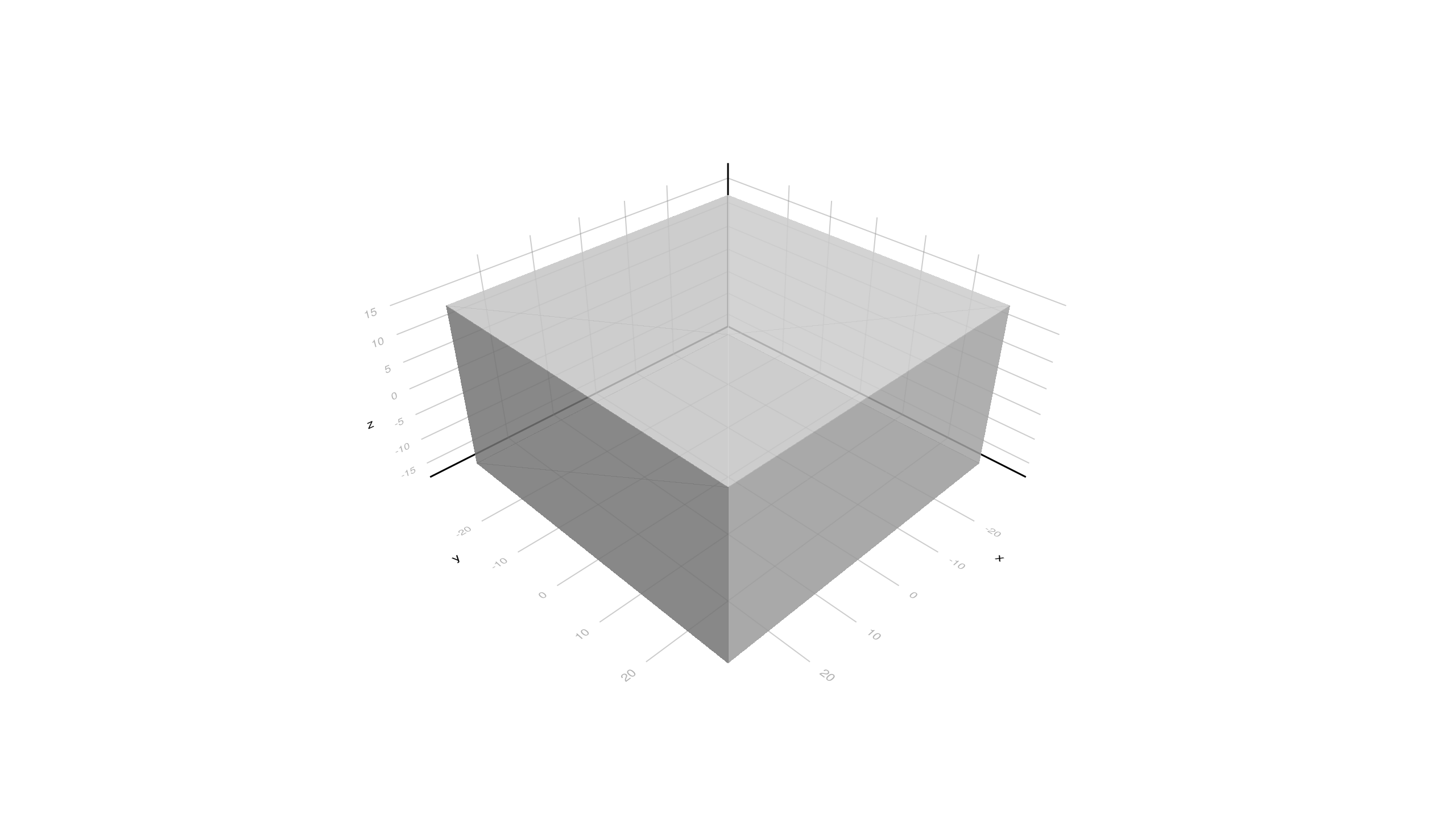
Placing Logical Volumes#
Placing a logical volume (solid+material) inside a mother volume is done by creating a G4PhysicalVolume.
nb_cryst = 32
Δϕ = 2π/nb_cryst
ring_R1 = 0.5 * cryst_dY/tan(Δϕ/2)
ring_R2 = (ring_R1+cryst_dZ)/cos(Δϕ/2)
# mother volume
solidRing = G4Tubs("Ring", ring_R1, ring_R2, cryst_dX/2, 0., 2π)
logicRing = G4LogicalVolume(solidRing, m_air, "Ring")
# placing the crystals
for icrys in 0:nb_cryst-1
ϕ = icrys*Δϕ
rotm = G4RotationMatrix()
rotateY(rotm, π/2)
rotateZ(rotm, ϕ)
position = (ring_R1 + cryst_dZ/2) * G4ThreeVector(cos(ϕ), sin(ϕ), 0)
transform = G4Transform3D(rotm, position)
G4PVPlacement(transform, # rotation,position
logicCryst, # its logical volume
"crystal", # its name
logicRing, # its mother volume
false, # no boolean operation
icrys, # copy number
false) # checking overlaps
end
A draw it
img = draw(logicRing)
display("image/png", img)
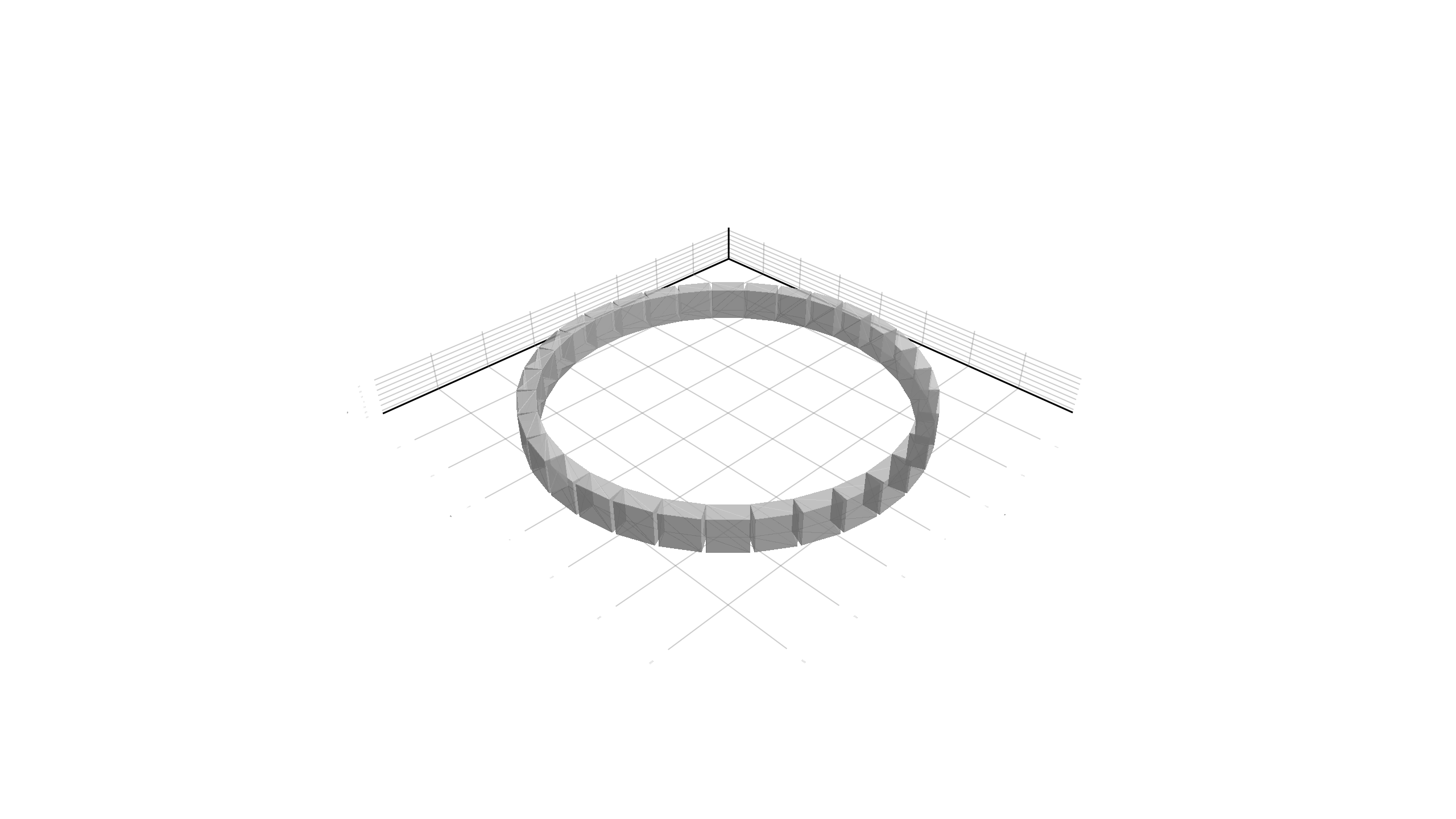
Building the full detector#
The detector construction is triggered by the G4RunManager at the right moment during the initialization steps. For this the user needs to provide a detector constructor function that will be called by the toolkit. The signature of the function is
function construct(det::<DetectorParameters>)::CxxPtr{G4VPhysicalVolume}
...
return world
end
It receives an instance of a user defined structure with all the parameters of the detector and returns a ‘pointer’ to the ‘world’ physical volume. The user needs to declare the constructor function by defining a function specific to the Parameters structure like this:
Geant4.getConstructor(::<DetectorParameters>)::Function = construct
Here is a an example:
using Parameters # we use the Parameters package to be able to define structure with keyword arguments with defaults
@with_kw mutable struct DetectorB3 <: G4JLDetector
cryst_dX::Float64 = 6cm
cryst_dY::Float64 = 6cm
cryst_dZ::Float64 = 3cm
nb_cryst::Int32 = 32
nb_rings::Int32 = 9
patient_radius::Float64 = 8cm
patient_dZ::Float64 = 10cm
checkOverlaps::Bool = false
end
detector = DetectorB3(nb_cryst = 64)
DetectorB3
cryst_dX: Float64 60.0
cryst_dY: Float64 60.0
cryst_dZ: Float64 30.0
nb_cryst: Int32 64
nb_rings: Int32 9
patient_radius: Float64 80.0
patient_dZ: Float64 100.0
checkOverlaps: Bool false
then we define the detector constructor function which includes the material definitions, and eventually the visualization attributes
function construct(det::DetectorB3)::G4VPhysicalVolume
(; cryst_dX, cryst_dY, cryst_dZ, nb_cryst, nb_rings, patient_radius, checkOverlaps, patient_dZ) = det
#---Derived parameters-------------------------------------------------------------------------
dPhi = 2π/nb_cryst
half_dPhi = 0.5*dPhi
cosdPhi = cos(half_dPhi)
tandPhi = tan(half_dPhi)
ring_R1 = 0.5*cryst_dY/tandPhi
ring_R2 = (ring_R1+cryst_dZ)/cosdPhi
detector_dZ = nb_rings*cryst_dX
world_sizeXY = 2.4*ring_R2
world_sizeZ = 1.2*detector_dZ
#---Materials----------------------------------------------------------------------------------
nist = G4NistManager!Instance()
default_mat = FindOrBuildMaterial(nist, "G4_AIR")
cryst_mat = FindOrBuildMaterial(nist, "Lu2SiO5")
#---Volumes------------------------------------------------------------------------------------
solidWorldS = G4Box("world", world_sizeXY/2, world_sizeXY/2, world_sizeZ/2)
logicWorld = G4LogicalVolume(solidWorldS, default_mat, "World")
physWorld = G4PVPlacement(nothing,
G4ThreeVector(), # at (0,0,0)
logicWorld, # its logical volume
"World", # its name
nothing, # its mother volume
false, # no boolean operations
0, # copy number
checkOverlaps) # checking overlaps
solidRing = G4Tubs("Ring", ring_R1, ring_R2, cryst_dX/2, 0., 2π)
logicRing = G4LogicalVolume(solidRing, default_mat, "Ring")
gap = 0.5mm
dX = cryst_dX - gap
dY = cryst_dY - gap
solidCryst = G4Box("crystal", dX/2, dY/2, cryst_dZ/2)
logicCryst = G4LogicalVolume(solidCryst, cryst_mat, "CrystalLV")
# place crystals within a ring
for icrys in 0:nb_cryst-1
ϕ = icrys*dPhi
rotm = G4RotationMatrix()
rotateY(rotm, π/2)
rotateZ(rotm, ϕ)
position = (ring_R1 + cryst_dZ/2) * G4ThreeVector(cos(ϕ), sin(ϕ), 0)
transform = G4Transform3D(rotm, position)
G4PVPlacement(transform, # rotation,position
logicCryst, # its logical volume
"crystal", # its name
logicRing, # its mother volume
false, # no boolean operation
icrys, # copy number
checkOverlaps) # checking overlaps
end
# full detector
solidDetector = G4Tubs("Detector", ring_R1, ring_R2, detector_dZ/2, 0., 2π)
logicDetector = G4LogicalVolume(solidDetector, default_mat, "Detector")
# place rings within detector
OG = -0.5*(detector_dZ + cryst_dX)
for iring in 0:nb_rings-1
OG += cryst_dX
G4PVPlacement(nothing, # no rotation
G4ThreeVector(0, 0, OG), # position
logicRing, # its logical volume
"ring", # its name
logicDetector, # its mother volume
false, # no boolean operation
iring, # copy number
checkOverlaps) # checking overlaps
end
# place detector in world
G4PVPlacement(nothing, # no rotation
G4ThreeVector(), # at (0,0,0)
logicDetector, # its logical volume
"Detector", # its name
logicWorld, # its mother volume
false, # no boolean operation
0, # copy number
checkOverlaps) # checking overlaps
# patient
patient_mat = FindOrBuildMaterial(nist, "G4_BRAIN_ICRP")
solidPatient = G4Tubs("Patient", 0., patient_radius, patient_dZ/2, 0., 2π)
logicPatient = G4LogicalVolume(solidPatient, patient_mat,"PatientLV")
G4PVPlacement(nothing , # no rotation
G4ThreeVector(), # at (0,0,0)
logicPatient, # its logical volume
"Patient", # its name
logicWorld, # its mother volume
false, # no boolean operation
0, # copy number
checkOverlaps) # checking overlaps
#---Visualization attributes-------------------------------------------------------------------
SetVisAttributes(logicWorld, G4VisAttributes!GetInvisible())
SetVisAttributes(logicRing, G4VisAttributes!GetInvisible())
SetVisAttributes(logicDetector, G4VisAttributes!GetInvisible())
#---Always return the physical world-----------------------------------------------------------
return physWorld
end
construct (generic function with 1 method)
world = construct(detector)
Geant4.G4PVPlacementAllocated(Ptr{Nothing} @0x00000000097365b0)
img = draw(world)
display("image/png", img)
